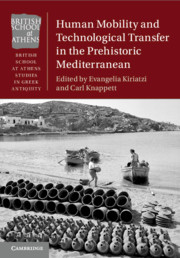Book contents
- Human Mobility and Technological Transfer in the Prehistoric Mediterranean
- British School at Athens Studies in Greek Antiquity
- Human Mobility and Technological Transfer in the Prehistoric Mediterranean
- Copyright page
- Contents
- Figures and Maps
- Tables
- Contributors
- Foreword
- Acknowledgements
- 1 Technological Mobilities: Perspectives from the Eastern Mediterranean – An Introduction
- 2 The Transmitting Sea: A Mediterranean Perspective
- 3 Changing Pottery Technology in the Later Neolithic in Macedonia, North Greece
- 4 Mobility and Early Bronze Age Southern Aegean Metal Production
- 5 Stonemasons and Craft Mobility in the Bronze Age Eastern Mediterranean
- 6 Towards an Understanding of the Origin of Late Bronze Age Greek Glass
- 7 Mobilities in the Neopalatial Southern Aegean: The Case of Minoanisation
- 8 The Archaeological Signatures of Mobility: A Technological Look at ‘Aegeanising’ Pottery from the Northern Levant at the End of the 2nd Millennium BC
- 9 Mycenaean and Mycenaeanising Pottery across the Mediterranean: A Multi-Scalar Approach to Technological Mobility, Transmission and Appropriation
- 10 Interpreting Bronze Age Trade and Migration
- 11 Commentary: States and Technological Mobility – A View from the West
- 12 Commentary: On Fluxes, Connections and their Archaeological Manifestations
- Bibliography
- Index
7 - Mobilities in the Neopalatial Southern Aegean: The Case of Minoanisation
Published online by Cambridge University Press: 21 January 2017
- Human Mobility and Technological Transfer in the Prehistoric Mediterranean
- British School at Athens Studies in Greek Antiquity
- Human Mobility and Technological Transfer in the Prehistoric Mediterranean
- Copyright page
- Contents
- Figures and Maps
- Tables
- Contributors
- Foreword
- Acknowledgements
- 1 Technological Mobilities: Perspectives from the Eastern Mediterranean – An Introduction
- 2 The Transmitting Sea: A Mediterranean Perspective
- 3 Changing Pottery Technology in the Later Neolithic in Macedonia, North Greece
- 4 Mobility and Early Bronze Age Southern Aegean Metal Production
- 5 Stonemasons and Craft Mobility in the Bronze Age Eastern Mediterranean
- 6 Towards an Understanding of the Origin of Late Bronze Age Greek Glass
- 7 Mobilities in the Neopalatial Southern Aegean: The Case of Minoanisation
- 8 The Archaeological Signatures of Mobility: A Technological Look at ‘Aegeanising’ Pottery from the Northern Levant at the End of the 2nd Millennium BC
- 9 Mycenaean and Mycenaeanising Pottery across the Mediterranean: A Multi-Scalar Approach to Technological Mobility, Transmission and Appropriation
- 10 Interpreting Bronze Age Trade and Migration
- 11 Commentary: States and Technological Mobility – A View from the West
- 12 Commentary: On Fluxes, Connections and their Archaeological Manifestations
- Bibliography
- Index
Summary
The plentiful circulation of many kinds of materials across the southern Aegean is one of the hallmarks of Minoanisation that all scholars can agree upon. However, what this circulation means in terms of the mobility of people is still very much debated. Are we to think that entire groups of people migrated from Crete to set up colonies across the wider region? Or should we instead imagine just enough circulation and contact for different groups to exchange goods and imitate certain objects and practices? Here we seek to contribute to this debate by assessing two technologies that appear to have been developed on Crete and then transferred in some way across the southern Aegean: fresco wall painting, and aspects of pottery production techniques, such as wheel-fashioning. Such technological practices require extended periods of learning, and perhaps even apprenticeships. We consider what the acquisition of such technologies – surely implying extended exposure to skilled artisans – suggests for the social mobilities underwriting Minoanisation.
- Type
- Chapter
- Information
- Publisher: Cambridge University PressPrint publication year: 2016
- 3
- Cited by

